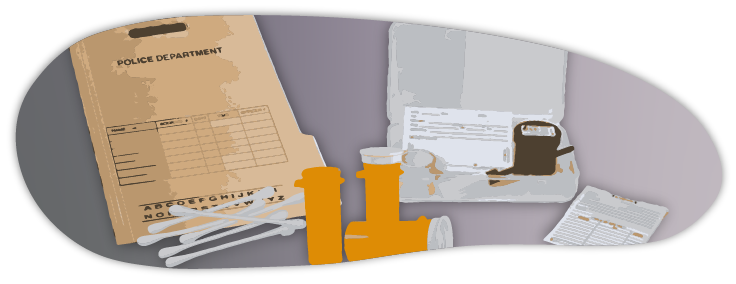A forensic exam kit also known as a rape kit, or sexual assault evidence kit – is a thorough medical examination conducted to collect and document physical evidence after sexual assault. DNA evidence from a crime like sexual assault can be collected from the crime scene, but it can also be collected from your body, clothes, and other personal belongings. This kit is used for investigative purposes by the police, and the use of this kit is entirely up to your discretion. As part of this exam, the following samples may be collected:
- Oral
- Fingernail
- Skin
- Hair
- Urine
- Blood
- Genitalia
Along with this, photographs of injuries, and clothing articles are also collected and stored as evidence. These samples are important to record evidence of assault, and potentially uncover the assailant’s DNA. Prior to this exam, a medical examination is conducted to treat injuries, and prevent pregnancy and STIs. This is often a difficult experience, and you are welcome to stop the process at any moment. Your comfort and consent at each step are the key to moving forward during the examination.
You are given a choice to have the collected evidence stored for a limited period of time or sent to the police. If you decide to pursue legal action, examination centers offer assistance in contacting the police and filing a report. In the case that you are unsure about reporting, evidence collected will be frozen, and stored at the center for up to one year*.
The length of the exam may take a few hours, but the actual time will vary based on several different factors.
As a part of this exam, you are encouraged to prepare yourself and know what to expect when you walk in.

How to prepare for a sexual assault forensic exam
If you are considering having a forensic exam done, here are some things that you can do to ensure that evidence is protected. If possible, do not
- Change clothes or shoes
- Shower, wash body, or hair
- Brush your teeth
- Douche
- Urinate
Remember to bring an extra pair of clothing, as clothing from the assault may be collected. The best evidence can be collected up to 72 hours after the assault. The earlier the visit, the more evidence that can be collected and the sooner that injuries, or STIs, and pregnancy prevention can be administered. However, you can still come in after the 72 hours to get a kit administered.
This is undeniably a difficult experience. To make it easier to navigate, bring along someone you trust. Some assault crisis centers will send someone to accompany you to the examination if you wish, often called an advocate. Be aware that if you invite someone other than an advocate into the exam room, they could be called as a witness if you decide to report the crime.
What happens during a sexual assault forensic exam?
Here are steps from RAINN of what to expect during a sexual assault forensic exam:
- Immediate care. If you have injuries that need immediate attention, those will be taken care of first.
- History. You will be asked about your current medications, pre-existing conditions, and other questions pertaining to your health history. Some of the questions, such as those about recent consensual sexual activity, may seem very personal, but these questions are designed to ensure that DNA and other evidence collected from the exam can be connected to the perpetrator. You will also be asked about the details of what has happened to you to help identify all potential areas of injury as well as places on your body or clothes where evidence may be located.
- Head-to-toe examination. This part of the exam may be based on your specific experience, which is why it is important to give an accurate history. It may include a full body examination, including internal examinations of the mouth, vagina, and/or anus. It may also include taking samples of blood, urine, swabs of body surface areas, and sometimes hair samples. The trained professional performing the exam may take pictures of your body to document injuries and the examination. With your permission, they may also collect items of clothing, including undergarments. Any other forms of physical evidence that are identified during the examination may be collected and packaged for analysis, such as a torn piece of the perpetrator’s clothing, a stray hair, or debris.
- Possible mandatory reporting. If you are a minor, the person performing the exam may be obligated to report it to law enforcement.
- Follow up care. You may be offered prevention treatment for STIs and other forms of medical care that require a follow up appointment with a medical professional. Depending on the circumstances and where you live, the exam site may schedule a follow up appointment, or you can ask about resources in your community that offer follow up care for survivors of sexual assault. Someone from the exam site may also be able to provide information or resources about reporting options.
*The time frame of one year is accurate in Ontario, Canada as of the published date. We encourage you to check your local regulations as it varies by jurisdiction.
Sources:
https://www.sadvtreatmentcentres.ca/assets/resource_library/members_only/OHA_Guidelines.pdf
Sexual Assault Evidence Kit (SAEK)
https://www.rainn.org/articles/rape-kit

Legal Disclaimer:
Our website provides general information that is intended, but not guaranteed, to be correct and up-to-date. The information is not presented as a source of legal advice. You should not rely, for legal advice, on statements or representations made within the website or by any externally referenced Internet sites. If you need legal advice upon which you intend to rely in the course of your legal affairs, consult a competent, independent attorney. Vesta Social Innovation Technologies does not assume any responsibility for actions or non-actions taken by people who have visited this site, and no one shall be entitled to a claim for detrimental reliance on any information provided or expressed.
